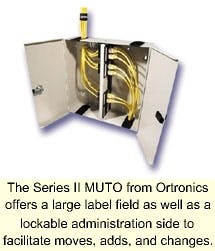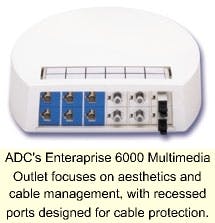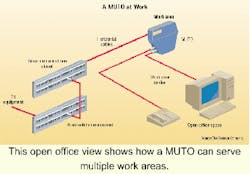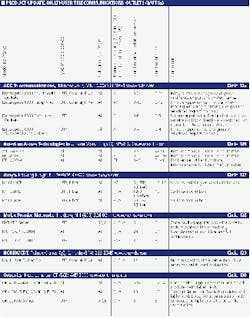Michelle Abrams
Every sports fan delights in those situations when an athlete is "in the zone"-when all the components of quality play come together and form a perfect fit, resulting in premier performance. This is how many in the cabling industry feel about being "in the zone," too. Zone cabling, that is-something that has come about with the rise of open-office architecture. Industry experts agree that zone cabling could never have become popular without the multi-user telecommunications outlet (MUTO).
MUTOs (sometimes known as MUTOAs-adding the word "assemblies") are an integral component to any zone cabling system. (See Product Update table on page 72.) They are designed to facilitate open office designs that are destined to be frequently reconfigured. The BICSI Telecommunications Dictionary defines a MUTO as "a group of telecommunications outlets that are arranged together in a single assembly housing." As the assembly is then typically located within a grouping of modular furniture, it is well constructed to protect from the strain of a bustling workplace. MUTOs help protect cables from tampering or from being tripped over.
Solid, single-unit MUTOs let you terminate single or multiple horizontal cables in one central location, such as within an area of modular furniture. They provide the intermediary point between the tele-communications closet and the workstation, increasing the ease of moves, adds and changes (MACs) by reducing the amount of cable that must be disturbed when rearranging workstations.
Like many components in the cabling industry, while MUTOs have been in existence for some time, they have recently garnered renewed interest. The roots of both zone cabling and MUTOs, says BICSI master instructor Phil Klingen-smith, president of Compass Tele-communications Consulting Corp., can be traced back to 1970s interest in zoned voice communications. But Klingensmith notes that those early installation methods saw punchdown blocks placed in the ceiling tiles, presenting a fire hazard, and "a very bad rap for zone cabling."
In fact, the concept of zoned cabling seemed to disappear until the advent of modular furniture. Contemporary zone cabling almost becomes a chicken and egg question: which came first, prominence of zone cabling and MUTOs, or open office architecture? John Wages, associate product manager for the Siemon Company (Watertown, CT), says "they feed off each other and are a great complement to one another." Open office architecture, Wages says, would not be feasible without MUTOs, and MUTOs would not be as prominent without open office architecture. Combining the two enables today's zone cabling design.
Design flexibility
"Building managers wanted something that can be cabled out to an area, even if we don't know what the final room will look like," observes Klingensmith, and MUTOs make this possible by allowing all forms of media to be cabled out from the telecommunications closet to the work area. Once the office areas are fully constructed, MUTOs help to maximize work space by receiving the cable from the telecommunications closet, and then to the workstation via a patch cord.
Jane Livingston, ADC's (Minneapolis, MN) director of data connectivity systems, credits the birth of open office architecture to California, where businesses first began to do away with walled offices and move to the open, cubicle style. As this office environment developed, there was a need to get the cable down from the ceiling and to the workstations without cable poles or lengthy cable runs. MUTOs proved to be an ideal solution.
A component aimed at simplifying the wiring process, MUTOs are a gathering of several outlets brought together in one casing, and can be mounted to the ceiling, floor, modular furniture, or walls. The MUTO, according to Klingensmith, "puts the pathway for the media right on top of the furniture and allows you to come in from the ceiling, floor or wall and go directly into the furniture." The result is increased ease of MACs.
When designing MUTOs for MACs, ADC considers ease of use, installation, and access. In the design process, Livingston says, the question becomes: "Is the product robust enough to handle the high exposure of an office place?" MUTOs, she says, must be designed to withstand abuse and ultimately uphold signal integrity. Jay Lahman, senior product manager for ADC, adds that "It is up to the installer to put the MUTO in a protected area, inside a cabinet or some other such area, to assure it won't be kicked or abused by the users."
Unlike some connectivity devices, MUTOs are specifically mentioned in TIA/EIA standards, such as TSB-75: "Work area cables originating from the multi-user telecommunications outlet assembly should be routed through work area pathways (e.g., furniture pathways). The work area cables shall be connected directly to work area equipment without the use of any additional intermediate connections." TSB-75, however, allows for longer lengths of patch cords to be used when making a connection from the MUTO to the workstation.
The standard also says that no more than 12 workstations should be served by the same MUTO. On average, there are three ports per workstation, which would equate to 36 ports available on the MUTO. Several manufacturers limit the number of workstations to less than 12. The Siemon Company, for example, advises that no more than six workstations be served by the same MUTO because it will eliminate the need for long lengths of work area cable, and improves administration of work area connections.
Family resemblance
MUTOs are often spoken in the same breath as consolidation points, and while similar in function, consolidation points are best described as distant cousins rather than interchangeable siblings. Consolidation points are interconnection points between horizontal cables running from the closet to those running to the work area. MUTOs are termination points for the horizontal cable.
Consolidation points require an outlet at the work area, meaning an extra step in the connectivity process because horizontal cable is run to the consolidation point and punched down, and then another horizontal cable is run from the consolidation point to an outlet at the work area. From that outlet, a connection can finally be made to the workstation. The MUTO, meanwhile, lets you terminate the horizontal cable and then run directly to the workstation via a patch cord.
An additional difference, says Klingensmith, is that solid wire rather than a patch cord is being run to the work area from a consolidation point. Patch cords feature stranded wire and provide additional flexibility plus 20% more attenuation, which, Klingensmith says, are keys in adding versatility to today's workstations.
ADC's Lahman says, "From the implementation of management perspective, the consolidation point has a higher density of users." Consolidation points should be utilized when it is necessary to serve more than 12 users. The Siemon Company's Wages notes that the typical number of users for a consolidation point is between 20 and 30, compared to the average of 6 to 12 with a MUTO.
Can the two components be used together? Says Lahman, "You could, depending on how the system is set up; however, you typically won't see the two together." But Klingensmith points out that you may find both in buildings that combine "walled" offices with the open-office concept.
Neat and tidy
"MUTOs are just now coming to the forefront as cable management comes out of the closet," notes Lahman, and several trends are already emerging, including the need for protection in construction. Wages concurs, saying "built-in management for fiber and copper (in the MUTO design) is important to help protect the bend radius." As the development of MUTOs moves forward, cable management will become increasingly important to the design process.
Lahman adds that ADC's product line has tried to focus on aesthetics as well as cable management. He notes the importance of the "accessibility for MACs without having to disturb other components, particularly since MUTOs are located directly in the work area." ADC's products, Lahman says, also aim to provide cable management for fiber slack storage, to preserve the signal integrity between the horizontal cable and the patch cord.
The Siemon Company's Wages says, "Since they [MUTOs] are in such a populated area, you want a smaller unit." Additionally, he believes there should be a "hidden designation area for network managers to easily keep track of labeling." ADC's Livingston agrees: "Labeling is a large issue and it is very important that you have the space to do this properly."
Perhaps the hottest aspect of MUTOs, says Wages, is their ability to bring multimedia applications to the workstation: "Multimedia is key and is very valuable to accompany anything to the desktop." The Siemon Company, in fact, is placing a high level of importance on developing products with multimedia capacity.
Yet with all the talk of the importance of MUTOs, surprisingly, they have yet to become popular with the U.S. Government. "The federal government rarely uses them," notes Tom Kenworthy, RCDD, MCSE, NNCDE of TEK Telcom Consulting. Kenworthy handles a great deal of government contracts in the Newport News, Virginia area, and has observed MUTOs primarily being used "in large, open-office commercial environments, and sometimes in university lab/library environments to allow furniture reconfiguration without re-cabling."
When selecting a MUTO, Klingen-smith says it must be "rated for the purpose." For instance, if the product is going into a plenum environment, it must be National Electrical Manufacturers Association (NEMA)-compliant. A MUTO should also be versatile, compatible with other manufacturers' connectivity products, and since modular furniture is expensive, Klingensmith says a MUTO should be able to blend in with the workspace. Several manufacturers will actually paint the MUTO to match its intended environment.
As with almost any cabling component, there are a variety of choices when it comes to making the final MUTO selection. But as Klingensmith quips, "It ain't rocket science. It is a very simple solution to a complex problem."
And essential for any cabling designer or installer who wants to get "in the zone."






